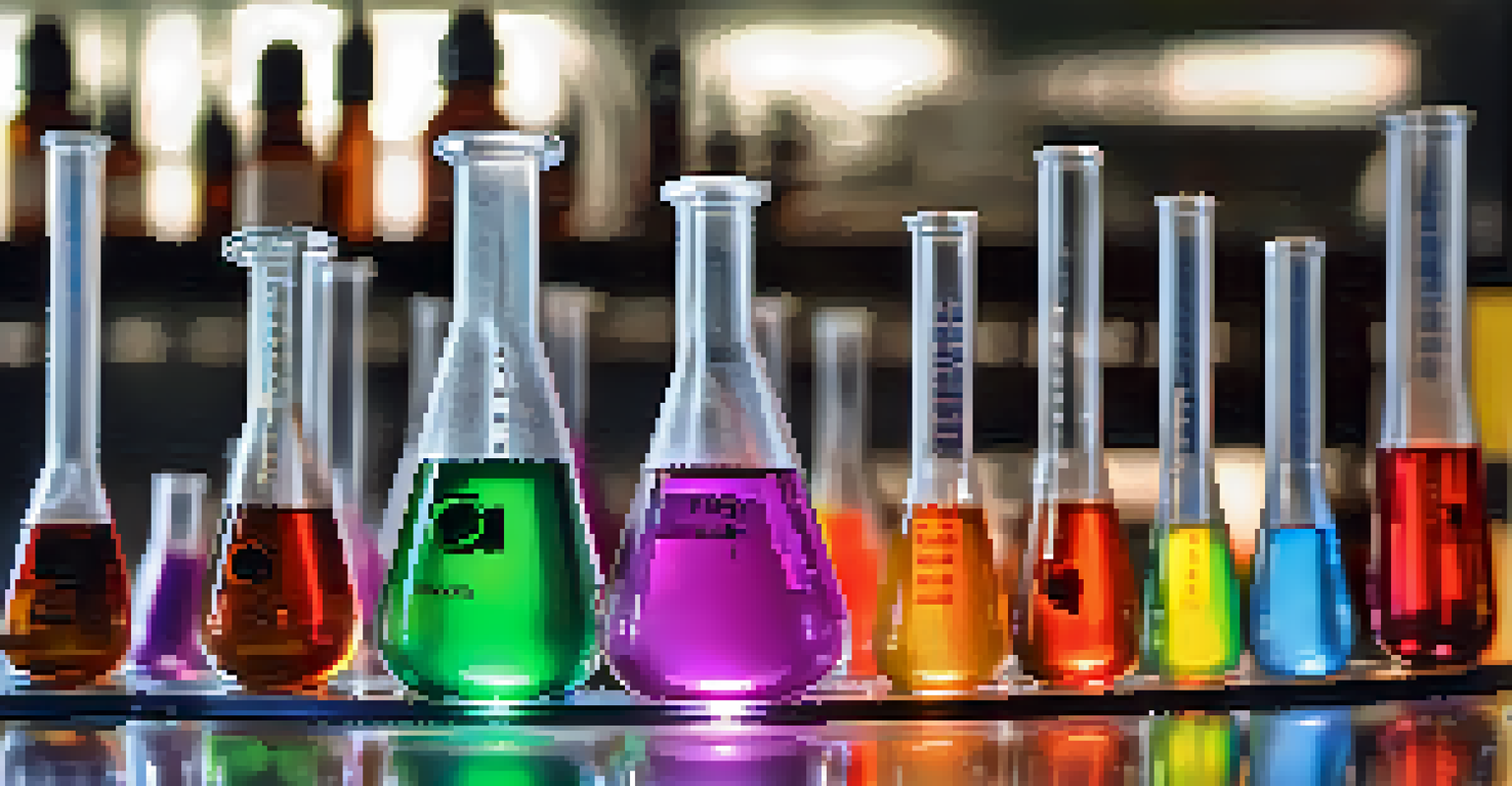The Mechanisms of Hallucinogens: A Deep Dive into Chemistry

Understanding Hallucinogens: An Introduction to Their Nature
Hallucinogens are substances that alter perception, mood, and various cognitive processes. These compounds can lead to vivid visual or auditory hallucinations, making them a subject of fascination and research. Notably, they come in various forms, including natural sources like mushrooms and synthetic creations like LSD.
The use of hallucinogens can help us understand the brain's processes and the nature of consciousness itself.
The appeal of hallucinogens spans cultures and centuries, often tied to spiritual or therapeutic practices. Their ability to induce altered states of consciousness has intrigued scientists and seekers alike. Understanding their chemistry is key to unlocking the mystery behind their effects and potential benefits.
In this article, we will dive deep into the mechanisms of hallucinogens, exploring how they interact with our brain chemistry and what makes them so unique. By the end, you’ll have a clearer picture of these complex substances and their impact on human experience.
The Chemistry of Hallucinogens: Key Compounds and Structures
At the heart of hallucinogens are specific chemical compounds that define their effects. For instance, psilocybin, found in magic mushrooms, converts into psilocin in the body, which mimics serotonin—a key neurotransmitter. This mimicry allows it to bind to serotonin receptors, particularly the 5-HT2A receptor, leading to altered perceptions.

Similarly, LSD (lysergic acid diethylamide) is a synthetic compound that also interacts with serotonin receptors. Its structure allows it to create profound changes in thought processes and sensory experiences. The delicate dance of these chemicals within our brains is what leads to the unique effects of each hallucinogen.
Hallucinogens Alter Perception
Hallucinogens are substances that significantly change perception, mood, and cognitive processes, allowing for vivid sensory experiences.
By understanding the molecular structures of these compounds, researchers can better appreciate how they produce their effects. This knowledge not only enhances our understanding of the substances themselves but also opens doors for potential therapeutic applications.
How Hallucinogens Affect the Brain: Mechanisms of Action
Hallucinogens primarily target the brain's serotonin system, which plays a crucial role in mood regulation and perception. When hallucinogens bind to serotonin receptors, they can disrupt normal signaling, leading to altered sensory experiences. This can result in vivid imagery, changes in thought patterns, and even a sense of unity with the universe.
Psychedelics can be a powerful tool for self-exploration, but they also require a deep respect for their potential risks.
The effects of hallucinogens can vary widely depending on the substance and individual context. For example, some users report feelings of euphoria and insight, while others may experience anxiety or paranoia. Understanding these effects is essential for both users and researchers as they explore the potential benefits and risks.
Additionally, the state of the user's mind and environment—often referred to as 'set and setting'—can greatly influence the experience. This highlights the importance of not only the chemical properties but also the psychological and environmental factors that contribute to the effects of hallucinogens.
The Role of Neurotransmitters in Hallucinogenic Experiences
Neurotransmitters are the chemical messengers in our brains that facilitate communication between neurons. Hallucinogens primarily engage with serotonin, but they can also affect other neurotransmitter systems, such as dopamine. This interaction is what leads to the complex array of sensations and emotions experienced during a trip.
For example, by stimulating serotonin receptors, hallucinogens can enhance emotional responses and sensory perception. This might explain why some users report profound insights or creative breakthroughs while under the influence. Neuroscientists are increasingly interested in these effects to explore potential therapeutic uses.
Therapeutic Uses Are Emerging
Research is uncovering the potential of hallucinogens like psilocybin and MDMA for treating conditions such as depression and PTSD.
Moreover, the interplay between different neurotransmitters can influence the overall experience. Understanding how hallucinogens modulate these systems can provide deeper insights into the brain's functioning and how altered states of consciousness can affect mental health.
Therapeutic Potential: Hallucinogens in Modern Medicine
In recent years, there has been a resurgence of interest in the therapeutic potential of hallucinogens. Research suggests that substances like psilocybin and MDMA may help treat conditions such as depression, PTSD, and anxiety. These findings have sparked a new wave of studies aimed at understanding how these compounds can be used safely and effectively.
Clinical trials are demonstrating that, under controlled settings, patients can experience significant relief from their symptoms. The therapeutic effects are believed to stem from the unique ways hallucinogens can alter perception and provide new perspectives on personal issues. This opens up conversations about integrating these substances into mainstream mental health treatments.
However, it’s important to approach this area with caution. While the potential is promising, further research is needed to fully understand the risks and benefits. As the medical community explores these options, a balanced discussion on the implications of using hallucinogens for therapy is essential.
Risks and Considerations: Navigating Hallucinogen Use
While hallucinogens can offer unique experiences and potential therapeutic benefits, they are not without risks. Adverse psychological reactions, such as anxiety, paranoia, or delusions, can occur, particularly in users with a history of mental health issues. This underscores the importance of understanding one’s mental state before considering use.
Moreover, the legality of these substances varies widely across different regions, adding another layer of complexity to their use. Users must be aware of local laws and the potential legal consequences of possession or use. Educating oneself about the substances can help mitigate risks and promote safer experiences.
Risks Require Caution
While hallucinogens may offer benefits, they also pose risks including adverse psychological reactions and legal implications.
Ultimately, the decision to explore hallucinogens should not be taken lightly. Open conversations about safety, mental health, and proper guidance can lead to informed choices, reducing the likelihood of negative experiences while maximizing the potential benefits.
The Future of Hallucinogen Research: What Lies Ahead
As interest in hallucinogens grows, so does the need for comprehensive research. Current studies are just scratching the surface of what these substances can teach us about the human mind and mental health. Future research aims to explore various aspects, including long-term effects, optimal dosages, and the mechanisms behind their therapeutic potential.
Additionally, the cultural and societal implications of re-integrating hallucinogens into therapeutic practices will be a key area of focus. Understanding how different communities perceive these substances will be crucial for responsible integration into mental health care. This also raises questions about accessibility and ethical considerations in treatment.

In conclusion, the future of hallucinogen research is bright and filled with possibilities. As we continue to unravel the chemistry and effects of these substances, we may discover revolutionary ways to enhance mental health and well-being.